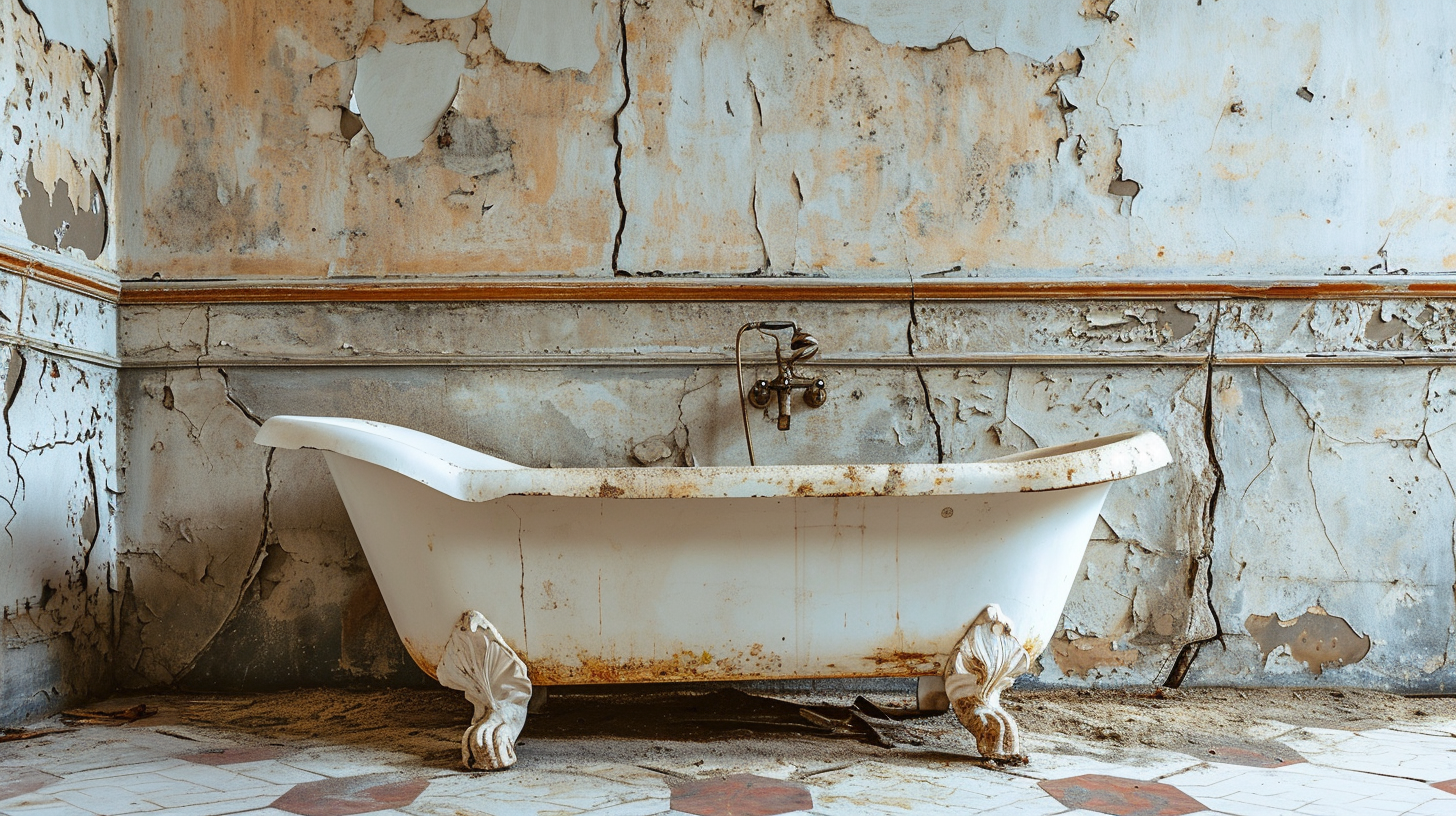Last Updated on 26th December 2023
Are you tired of looking at that unsightly crack in your bathtub? Rest assured, with the right tools and techniques, you can repair it yourself and restore your bathtub to its former glory. In this article, we will guide you through the step-by-step process of repairing a cracked bathtub. From assessing the damage to applying the final coat, we will provide you with professional tips and instructions to ensure a successful repair. So let’s get started and transform your bathtub back to its original pristine condition.
Assessing the Damage
We need to carefully assess the extent of the damage before determining the most suitable repair method. When evaluating the severity of a cracked bathtub, it is crucial to consider factors such as the size and location of the crack, as well as any underlying structural issues. While minor cracks can often be repaired using DIY methods, more severe damage may require professional help. It is important to find a skilled and experienced professional who specializes in bathtub repairs to ensure a proper assessment and effective repair. Attempting to fix a severely damaged bathtub without professional assistance may result in further damage or even potential safety hazards. By seeking professional help, we can ensure that the damage is accurately assessed and the appropriate repair method is employed for a long-lasting solution.
Gathering the Necessary Tools
Before beginning the bathtub repair process, it is essential to gather all the required tools, such as a putty knife, sandpaper, epoxy resin, and a caulking gun, in order to ensure a smooth and efficient repair. Choosing the right patching material is crucial to ensure a long-lasting and effective repair. There are various options available, such as acrylic or fiberglass patching compounds, which can be easily applied and provide a durable solution. Safety precautions during bathtub repair should not be overlooked. It is important to wear protective gloves and goggles to prevent any potential injuries from sharp edges or chemicals. Adequate ventilation should also be ensured to avoid inhaling any fumes. Taking these safety measures will help create a safe working environment and prevent any accidents during the repair process.
Preparing the Surface
In order to achieve a successful bathtub repair, it is imperative to thoroughly prepare the surface by removing any loose debris or old caulking. Surface preparation is a crucial step in the repair process as it ensures proper adhesion of the repair materials and enhances the longevity of the repair. To begin, use a scraper or putty knife to remove any loose debris or old caulking from the cracked area. Next, clean the surface with a mild detergent and warm water to remove any dirt or grease. Once the surface is clean and dry, it is ready for the application of repair techniques. Proper surface preparation sets the foundation for a durable and effective bathtub repair that will restore the functionality and aesthetic appeal of the bathtub.
Applying the Patching Material
After thoroughly preparing the surface, apply a thin layer of patching material to the cracked area using a putty knife, ensuring it is evenly spread and completely covers the damaged surface. Once the patching material is applied, it is important to allow sufficient time for it to dry before proceeding with further repairs. Drying techniques play a crucial role in ensuring a successful bathtub repair. One effective drying technique is to use a fan or a heat gun to expedite the drying process. Additionally, proper time management strategies should be employed to ensure that enough time is allocated for the patching material to fully dry. Rushing this step can lead to subpar results and potential future damage. By allowing adequate drying time and implementing efficient time management strategies, the repaired bathtub will be durable and functional for years to come.
Sanding and Smoothing the Repair
After applying the patching material to the cracks in the bathtub, the next step is to sand and smooth the repair. This process involves using sandpaper with different grit options to achieve the desired level of smoothness. Additionally, filling the cracks completely and applying the final finishing touches will ensure a seamless repair.
Sandpaper Grit Options
The sandpaper grit options available for sanding and smoothing the repair of a cracked bathtub should be carefully considered to ensure a flawless finish. When it comes to sanding techniques, choosing the right sandpaper is crucial. The grit refers to the coarseness of the sandpaper, and different grits are suitable for different stages of the repair process. For initial sanding to remove any rough edges or high spots, a coarse grit like 60 or 80 is recommended. This helps to level the surface and prepare it for further smoothing. As the repair progresses, a finer grit like 120 or 150 can be used to achieve a smoother finish. Finally, for the final touch, a very fine grit like 220 or higher can be used to polish the surface and make it ready for refinishing. By using the appropriate sandpaper grit options and following proper sanding techniques, one can effectively repair a cracked bathtub and achieve a seamless result.
Filling the Cracks
An effective method for filling the cracks in a bathtub repair involves carefully sanding and smoothing the surface to achieve a seamless finish. When it comes to repair methods for cracked bathtubs, this step is crucial in ensuring a successful outcome. By using sandpaper with varying grit options, professionals can remove any rough edges or protrusions around the cracks, creating a smooth and even surface. This not only improves the appearance of the repaired area but also helps to prevent further damage or water leakage. However, it is important to note that bathtub repairs can be complex and time-consuming, requiring professional assistance in many cases. Professionals have the necessary expertise and tools to properly assess and repair the cracks, ensuring a long-lasting and durable solution.
Final Finishing Touches
To achieve a flawless repair, professionals must meticulously sand down the surface, ensuring all imperfections are smoothed out for the final finishing touches of the cracked bathtub. Once the cracks have been filled and the surface is even, it is time to focus on the finishing techniques to restore the bathtub’s appearance. There are various finishing techniques available, such as applying a topcoat or glaze to provide a glossy finish or using a textured finish to create a more unique look. Additionally, color options play a crucial role in the final outcome of the repair. Professionals can match the existing color of the bathtub or offer different color options to give the bathtub a fresh and updated look. The right finishing techniques and color options can transform a cracked bathtub into a beautifully restored centerpiece in any bathroom.
Cleaning and Priming the Surface
Thoroughly cleaning and priming the surface is crucial for ensuring a smooth and durable bathtub repair. Before starting the repair process, it is important to remove any dirt, grime, or old paint from the surface of the bathtub. This can be done using various cleaning techniques such as scrubbing with a mixture of mild detergent and water, or using specialized bathtub cleaners. Once the surface is clean, it needs to be properly prepared for the repair. This involves sanding the area around the crack to create a rough surface that will allow the repair material to adhere better. Additionally, a primer should be applied to the prepared surface to further enhance adhesion and ensure a long-lasting repair. Proper cleaning techniques and surface preparation are essential steps in obtaining a successful bathtub repair.
Applying the Final Coat
After thoroughly cleaning and priming the surface, it is important to apply the final coat of bathtub repair material, ensuring a seamless finish and increased durability. Once the repair material has dried completely, it is time to focus on buffing techniques and polishing methods to further enhance the appearance of the bathtub. Buffing involves using a buffing pad or cloth to gently polish the surface, removing any imperfections and creating a smooth and glossy finish. Polishing methods can vary depending on the type of repair material used, but generally involve applying a polishing compound or wax to the surface and then buffing it with a clean cloth. This step not only adds shine to the bathtub but also helps protect the repaired area from future damage. It is essential to follow the manufacturer’s instructions and take necessary safety precautions while performing these tasks.
Allowing for Proper Drying Time
To ensure a successful bathtub repair, it is crucial to allow for proper drying time. Optimal drying techniques, such as using fans or heaters, can help expedite the process. Additionally, effective time management strategies, such as scheduling the repair during a period of low usage, can provide ample time for the bathtub to fully dry before it is used again.
Optimal Drying Techniques
In order to ensure the best results, it is crucial to implement optimal drying techniques, such as using a dehumidifier and allowing for sufficient air circulation, when repairing a cracked bathtub. Proper drying time management is essential to prevent moisture buildup, which can lead to further damage and potential health hazards. When repairing a cracked bathtub, it is important to thoroughly dry the affected area before applying any sealants or other repair materials. This can be achieved by using a dehumidifier to remove excess moisture from the air and allowing for sufficient air circulation. Additionally, ensuring that the area is properly ventilated can help expedite the drying process. By implementing these optimal drying techniques, one can effectively manage drying time and prevent moisture buildup, leading to a successful and long-lasting repair.
Time Management Strategies
Efficient time management, coupled with prioritization, is essential for ensuring proper drying time when repairing a cracked bathtub. When faced with a cracked bathtub, it is crucial to allocate enough time for the repair process, as rushing can lead to subpar results. To effectively manage time, it is helpful to create a schedule or checklist that outlines all the tasks involved in the repair. This will allow you to prioritize tasks based on their importance and urgency. Additionally, breaking down larger tasks into smaller, more manageable ones can help you stay organized and focused. It is also beneficial to eliminate distractions and create a conducive work environment to optimize productivity. By following these time management tips and effectively prioritizing tasks, you can ensure a smooth and efficient bathtub repair process.
Buffing and Polishing the Bathtub
While buffing and polishing the bathtub can enhance its appearance, it is essential to follow proper techniques to avoid damaging the surface. Buffing techniques involve using a buffer machine with the appropriate pad and speed settings to remove scratches and imperfections from the bathtub’s surface. It is important to choose the right polishing products for the material of the bathtub, such as acrylic, enamel, or fiberglass. Polishing products like abrasive compounds, polishes, and sealants can help restore the shine and luster of the bathtub. However, it is crucial to read and follow the instructions provided by the manufacturer to ensure proper usage and avoid any potential damage. Regular maintenance and using the correct buffing techniques and polishing products can help prolong the life and beauty of your bathtub.
Maintaining and Preventing Future Cracks
To effectively maintain your bathtub and prevent future cracks, it is crucial to regularly inspect the surface and apply a high-quality sealant every six months. By doing so, you can ensure the longevity of your bathtub and prevent costly repairs down the line. Regular inspections allow you to identify any signs of damage or wear, such as small cracks or chips, before they escalate into larger issues. When choosing repair materials, it is important to select products specifically designed for bathtub repair to ensure proper adhesion and durability. High-quality sealants and epoxy compounds are commonly used for repairing cracks in bathtubs. These materials provide a strong and long-lasting bond, preventing further damage and maintaining the integrity of the bathtub surface. By taking these preventative measures and using the right repair materials, you can extend the lifespan of your bathtub and avoid unnecessary expenses.




